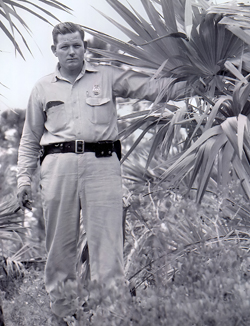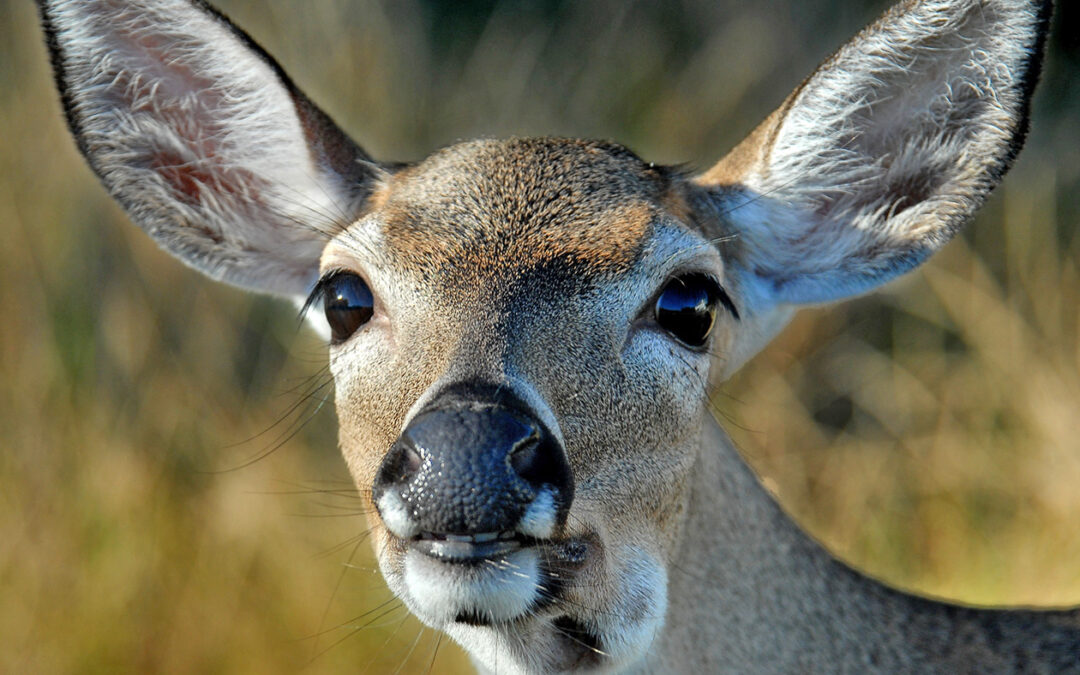 Have you ever seen a Key deer?
Have you ever seen a Key deer?
If you have never seen this diminutive creature, which is exclusive to the Florida Keys, you’re missing out on one of life’s simple pleasures. Key deer may be tiny in size, but this endangered species is big on the list of well-loved wildlife.
The smallest cousins of white-tailed deer, the largest bucks grow to less than a yard high at the shoulders and weigh about 80 pounds. The does are 24 to 28 inches at the shoulders and weigh about 65 pounds.
Key deer use many habitats in the Florida Keys including pine rocklands, hardwood hammocks, mangroves, and freshwater wetlands. However, they can only be found from Big Pine Key to Sugarloaf Key. The vast majority are concentrated on Big Pine and No Name Keys – two islands located right next to each other encompassing less than 12 square miles total area.
So how did these special deer get to the Keys, of all places?
They originally migrated from the mainland during the latest Ice Age when sea levels were much lower, their size shrinking over time as they adapted to the limited resources and warmer temperatures on these small island habitats.
Near extinction from habitat destruction and poaching in the 1950s led to a federal recovery effort which was soon backed by the 1957 establishment of the National Key Deer Refuge. Since then, the early herd of 25 deer has rebounded upwards to 800 – 1200 animals.
Located in the lower Florida Keys, the National Key Deer Refuge consists of approximately 9,200 acres of land that includes pine rockland forests, tropical hardwood hammocks, freshwater wetlands, salt marsh wetlands, and mangrove forests. It is also home to 23 endangered and threatened plant and animal species along with hundreds of others.
Even still, natural and human impacts like parasites, hurricanes, car collisions, poachers, climate change, rising sea levels, disease, dogs, and close proximity to homes and roads are ever-present threats.
All things considered, the Key deer population has proven to be surprisingly resilient. Their habitat continues to recover as well, as the refuge continues to monitor both the population of deer and the health of the habitat into the future. However, habituation to humans continues to be a challenge.
The biggest reason that the deer have lost their natural wariness around people is because they have been fed. When one of these sweet little darlings approaches you it’s more than likely that they are looking for a free handout.
When it comes to Key deer, there are some simple but strict rules to follow:
1. Do Not Pet! No matter how cute they are or how close they may get, forget about petting them. You are not a deer whisperer and they are (federally protected) wild animals. Touching, harassing, or possessing one is a federal offense.
2. Drive Carefully! Getting hit by vehicles is now the primary cause of Key deer deaths. Slow down while driving between Sugarloaf Keys east to Bahia Honda, with extra caution in Big Pine Key.
3. Do Not Feed! Resist the urge to offer Key Deer whatever it is you happen to have on hand. The only “feeding” that’s legal is the ecosystem’s native plants. Berries, leaves, and flowers from more than 150 native plants and trees— including palms, gumbo limbo, strangler figs, blackbead, blolly, black torch, sea grape, and pigeon plum — make up the Key deer diet.
4. A Fed Deer Can Lead to a Dead Deer. From a health perspective, feeding deer human foods, or foods they aren’t used to eating, can make the deer sick. In the case of cracked corn or dog food, it can kill them. Feeding them also habituates them to people, making them less wary around vehicles, dogs, trash, and even makes them susceptible to poaching.
Want to see more?
Stop by the National Key Deer Refuge Visitors Center run by US Wildlife on Big Pine Key. You’ll find a wealth of information here including where to see Key deer, hidden spots to explore, upcoming and ongoing events, new exhibits and lots of cool displays. The Center is open daily from 10am — 3pm Find it at 30587 Overseas Hwy, Big Pine Key. Info: 305-872-0774; FWS.gov.

Meet Jack Watson
The Key Deers’ Best Friend
Although ideas to protect Key Deer and set aside habitat land for them circulated in Congress and the White House in the 1930s and 40s, and hunting of Key Deer was outlawed in 1939, poaching and habitat destruction continued unabated.
The darkest times came around 1950 when only 50 Key Deer (or less) were alive in the world. The saving of Key Deer from total extinction is generally credited to one man: Jack Watson.
In 1946 Jack became an officer for the US Fish and Wildlife Service, and quickly became the Key Deer’s best friend — realizing not only how adorable but also how precariously close to extinction they were.
Jack declared a one-man war on poachers and used whatever tactics were necessary. These included disabling their cars with bullets to the engine or gas tank, or setting their boats on fire.
He also spent much time educating the government and public about the Deer and, in 1957 when the National Key Deer Refuge was (finally!) established, he became its first manager. He finally retired from that position in 1974.














